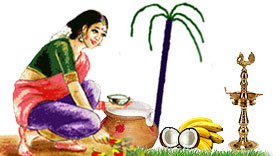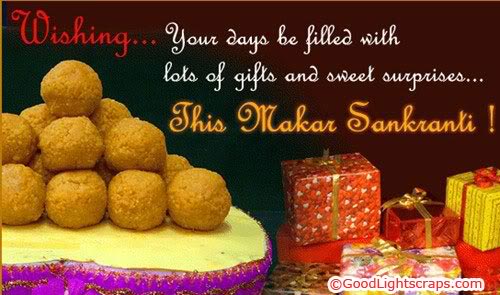!! Cut Stress In A Relationship !!
 10 Ways to cut stress in a relationship |

PLANT TREES TO SAVE ENVIRONMENT.
VISIT BLOG &FWD TO YOUR FRIENDS
GO THROUGH THE I LAND POSTS

OM SAIRAM Always be happy always wear a smile..not because life is full of reasons to smile but ur smile itself is the reason for many others to smile YOU MAY VISIT&FWD TO YOUR FRIENDS &GIVE ME FEED BACK, ramajayamgomati.blogspot.com Please do visit my blog and see what I have posted. Comments are requested THANKS REGARDS OM-SAIRAM
!! Cut Stress In A Relationship !!
 10 Ways to cut stress in a relationship |


   
ॐ _/\_ Om Namo Venkatesaya _/\_ ॐ
|








Pongal is a four day long harvest festival celebrated in Tamil Nadu, a southern state of India. For as long as people have been planting and gathering food, there has been some form of Harvest Festival. Pongal, one of the most important popular Hindu festivals of the year. This four-day festival of thanksgiving to nature takes its name from the Tamil word meaning "to boil" and is held in the month of Thai (January-February) during the season when rice and other cereals, sugar-cane, and turmeric (an essential ingredient in Tamil cooking) are harvested.  Mid-January is an important time in the Tamil calendar. The harvest festival, Pongal, falls typically on the 14th or the 15th of January and is the quintessential `Tamil Festival'. Pongal is a harvest festival, a traditional occasion for giving thanks to nature, for celebrating the life cycles that give us grain. Tamilians say `Thai pirandhaal vazhi pirakkum', and believe that knotty family problems will be solved with the advent of the Tamil month Thai that begins on Pongal day. This is traditionally the month of weddings. This is not a surprise in a largely agricultural community -- the riches gained from a good harvest form the economic basis for expensive family occasions like weddings. The First Day This first day is celebrated as Bhogi festival in honor of Lord Indra, the supreme ruler of clouds that give rains. Homage is paid to Lord Indra for the abundance of harvest, thereby bringing plenty and prosperity to the land. Another ritual observed on this day is Bhogi Mantalu, when useless household articles are thrown into a fire made of wood and cow-dung cakes. Girls dance around the bonfire, singing songs in praise of the gods, the spring and the harvest. The significance of the bonfire, in which is burnt the agricultural wastes and firewood is to keep warm during the last lap of winter. The Second Day On the second day of Pongal, the puja or act of ceremonial worship is performed when rice is boiled in milk outdoors in a earthenware pot and is then symbolically offered to the sun-god along with other oblations. All people wear traditional dress and markings, and their is an interesting ritual where husband and wife dispose off elegant ritual utensils specially used for the puja. In the village, the Pongal ceremony is carried out more simply but with the same devotion. In accordance with the appointed ritual a turmeric plant is tied around the pot in which the rice will be boiled. The offerings include the two sticks of sugar-cane in background and coconut and bananas in the dish. A common feature of the puja, in addition to the offerings, is the kolam, the auspicious design which is traditionally traced in white lime powder before the house in the early morning after bathing. The Third Day The third day is known as Mattu Pongal, the day of Pongal for cows. Multi-colored beads, tinkling bells, sheaves of corn and flower garlands are tied around the neck of the cattle and then are worshiped. They are fed with Pongal and taken to the village centers.. The resounding of their bells attract the villagers as the young men race each other's cattle. The entire atmosphere becomes festive and full of fun and revelry. Arati is performed on them, so as to ward off the evil eye. According to a legend, once Shiva asked his bull, Basava, to go to the earth and ask the mortals to have an oil massage and bath every day and to eat once a month. Inadvertently, Basava announced that everyone should eat daily and have an oil bath once a month. This mistake enraged Shiva who then cursed Basava, banishing him to live on the earth forever. He would have to plough the fields and help people produce more food. Thus the association of this day with cattle. The Fourth Day The Fourth day is known as Knau or Kannum Pongal day. On this day, a turmeric leaf is washed and is then placed on the ground. On this leaf are placed, the left overs of sweet Pongal and Venn Pongal, ordinary rice as well as rice colored red and yellow, betel leaves, betel nuts, two pieces of sugarcane, turmeric leaves, and plantains. In Tamil Nadu women perform this ritual before bathing in the morning. All the women, young and old, of the house assemble in the courtyard. The rice is placed in the centre of the leaf, while the women ask that the house and family of their brothers should prosper. Arati is performed for the brothers with turmeric water, limestone and rice, and this water is sprinkled on the kolam in front of the house. |
Inspite of immense urbanization, the traditions and customs attached to the harvest festival of Pongal has not diminished. Though the nature of these tradition and customs has changed, the glitter of this festival has not dimmed. The fast changing times notwithstanding, certain things do not change. The way we celebrate the festivals, for instance. The festival of Pongal captures the quintessence of south Indian culture in all its entirety and traditional practices and customs continue to hold their own even today. The spirit is alive and Pongal is still treated as a time to discard the old and welcome the new. The new crop that is harvested is cooked and offered to the Almighty. Celebrated for four days, the various traditions and customs of this harvest festival are: Bhogi Pongal The first day of Pongal known as 'Bhogi Pongal' is a day for family gathering and is dedicated to Lord Indra, the king of the deities and God of the Clouds and Rains. Offerings are made to him to please him so that he blesses us for the plentiful harvest. It is also the beginning of the New Year according to the Malayalam calendar and before sunrise, a huge bonfire of useless things in home is lit that is kept burning throughout the night. All the time, boys beat little buffalo-hide drums known as 'Bhogi Kottus'. The houses are then cleaned till they shine and are decorated with Kolams painted using rice four. There are yellow pumpkin flowers are set in cow-dung balls in the middle of these designs.  Surya Pongal The second day of Pongal known as 'Surya Pongal' is dedicated to the Sun God. The granaries are kept full on this day and Sun God with his rays are painted on a plank as he is worshiped with the birth of the new auspicious month of Thai. Since the word 'Ponga' means 'to boil' representing plentiful and excess yield, a special dish is cooked on this day in a new mud-pot that comes in innovative shapes and have artistic designs on them called 'Pongapani'. The special dish is called 'Sarkkarai Pongal' and is offered to Sun God with sugarcane sticks. It is said that Lord Sundareshwar performed a miracle on this day in the Madurai temple and breathed life into a stone elephant who ate sugarcanes. One can see the depiction of the event in the Meenakshi temple. Mattu Pongal The third day known as 'Mattu Pongal' is dedicated to the cattle as cowherds and shepherds pay thanks to their cows and bulls, paint their horns and cover them with shining metal caps. They are fed 'Pongal' and tinkling bells are tied around their neck. Cattle races are conducted and in the game called 'Manji Virattu' groups of young men chase running bulls. Bull fights called 'Jallikattu' are also arranged at some places where young men have to take the money bags tied to the horns of ferocious bulls single-handedly and without the use of arms. Lord Ganesha and Goddess Parvati are also worshiped on this day. At some other places, this day is celebrated as Kanu Pongal when girls feed colored balls of cooked rice to the birds and crows and pray for their brothers' happiness and that they always remember them.  Kaanum Pongal The fourth day is termed as Kaanum Pongal. On this day, people travel to see other family members. On this day, the younger members of the family pay homage to the elders, and the elders thank them by giving token money. Another thing many do is leave food out on banana leaves for birds to take. Many South Indian people will take the first bit of rice cooked in any given day and set it outside for the crows to take, so this is not necessarily a habit only for Pongal. |



